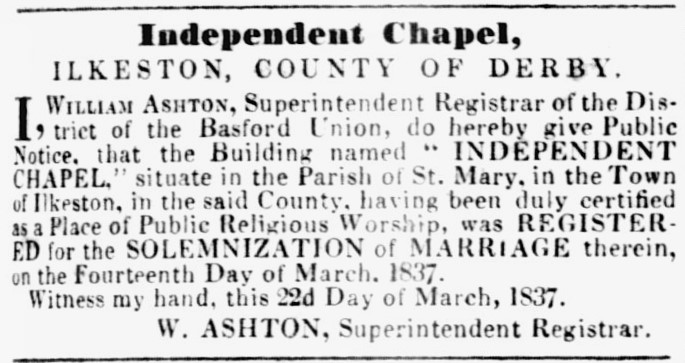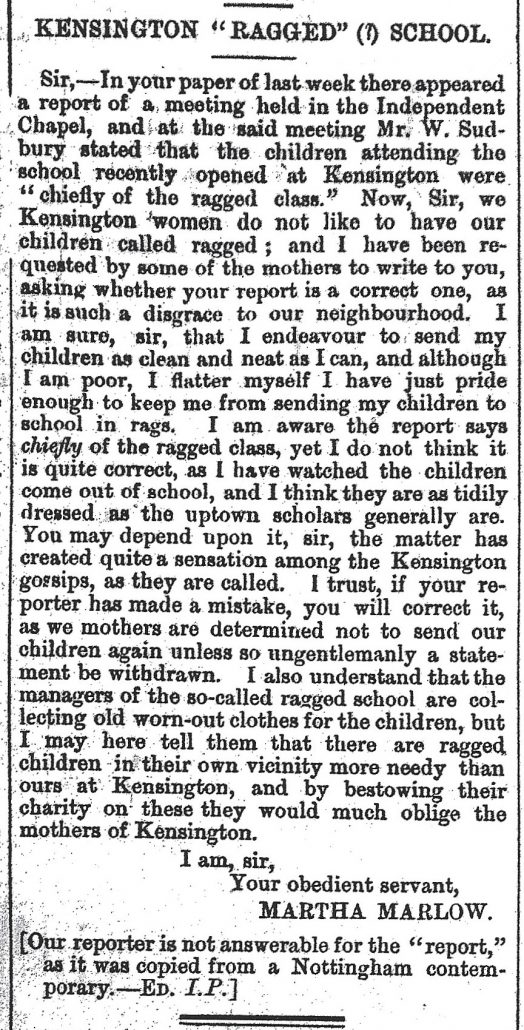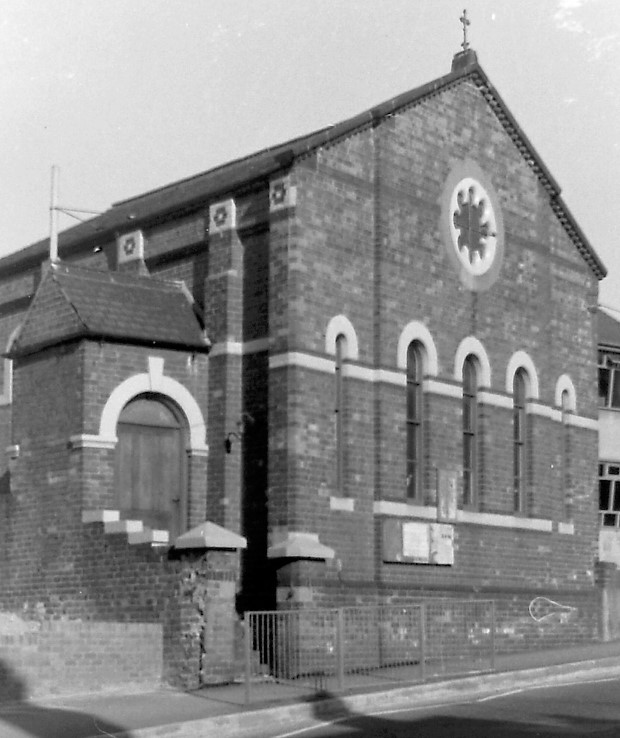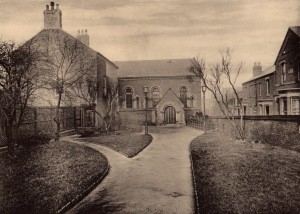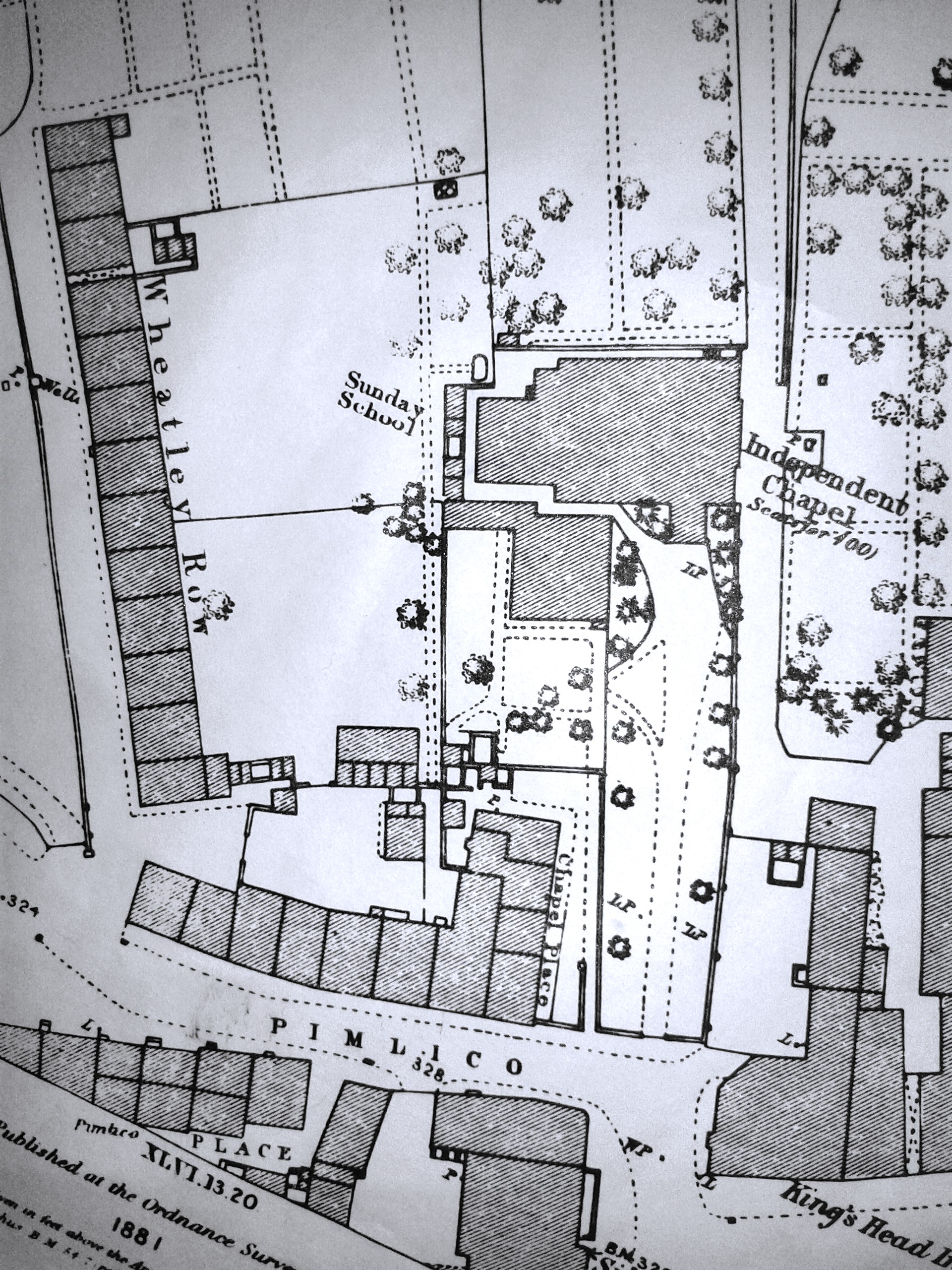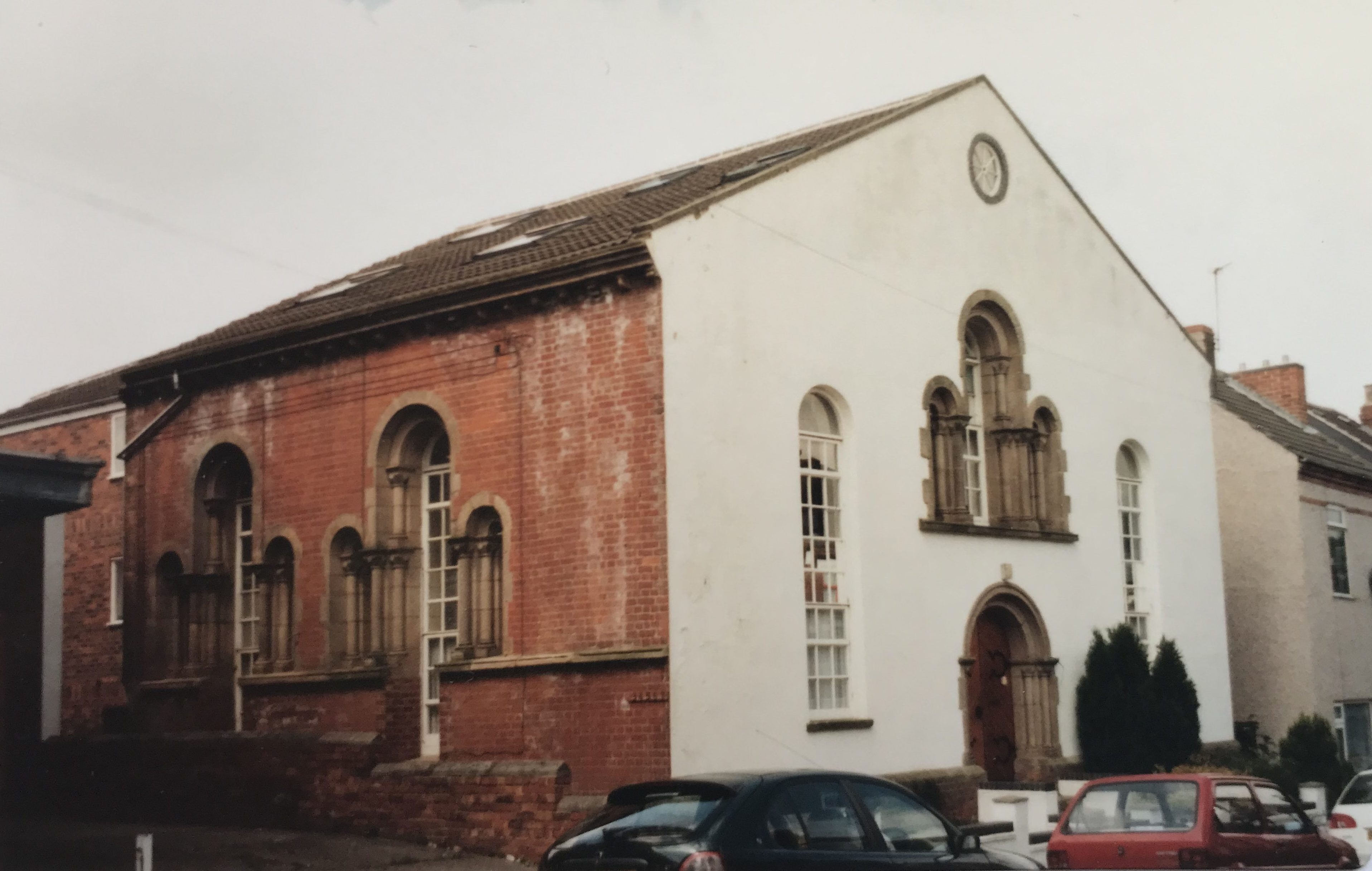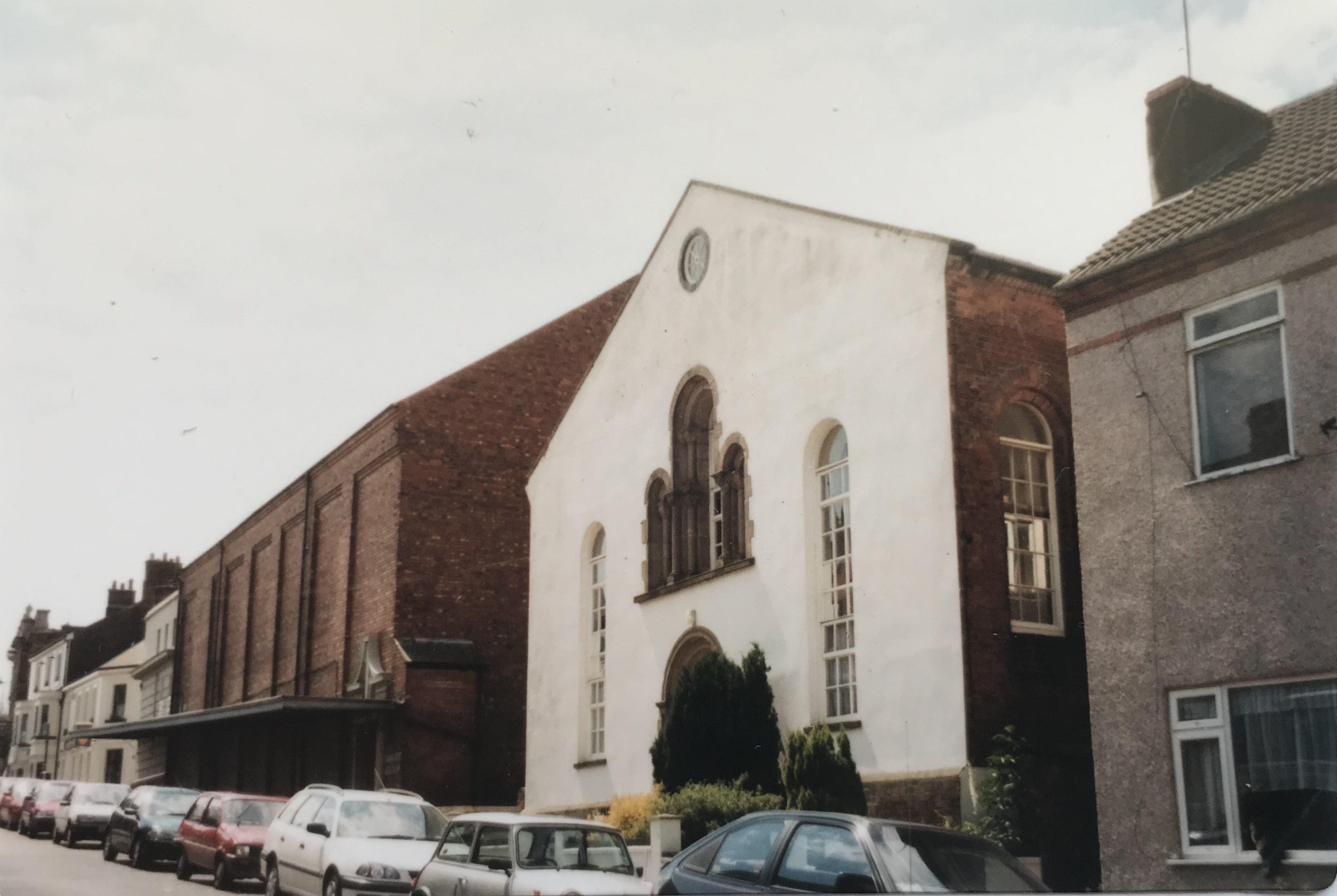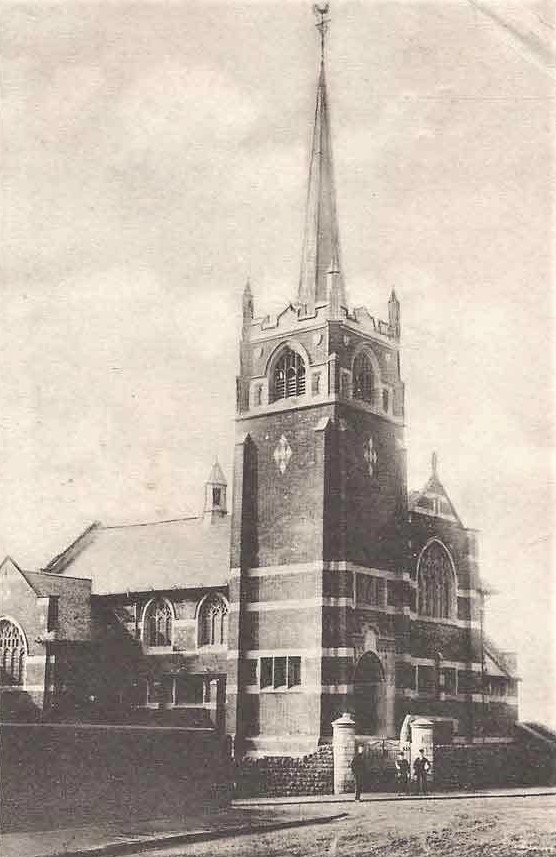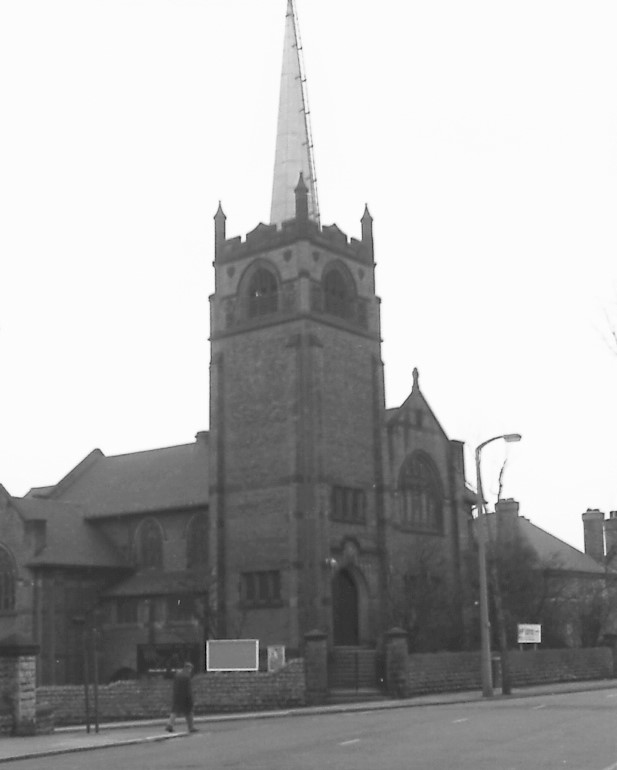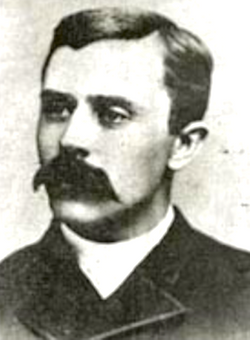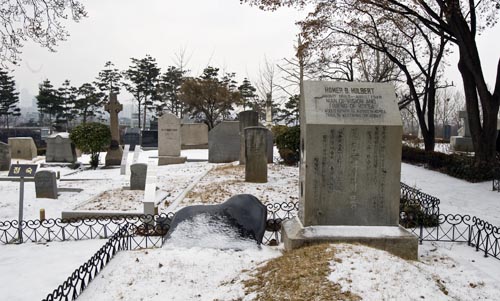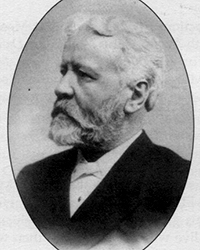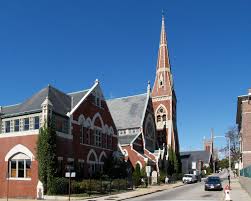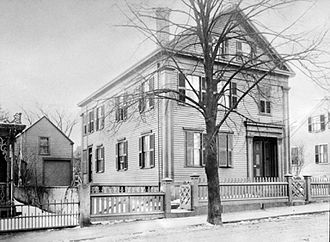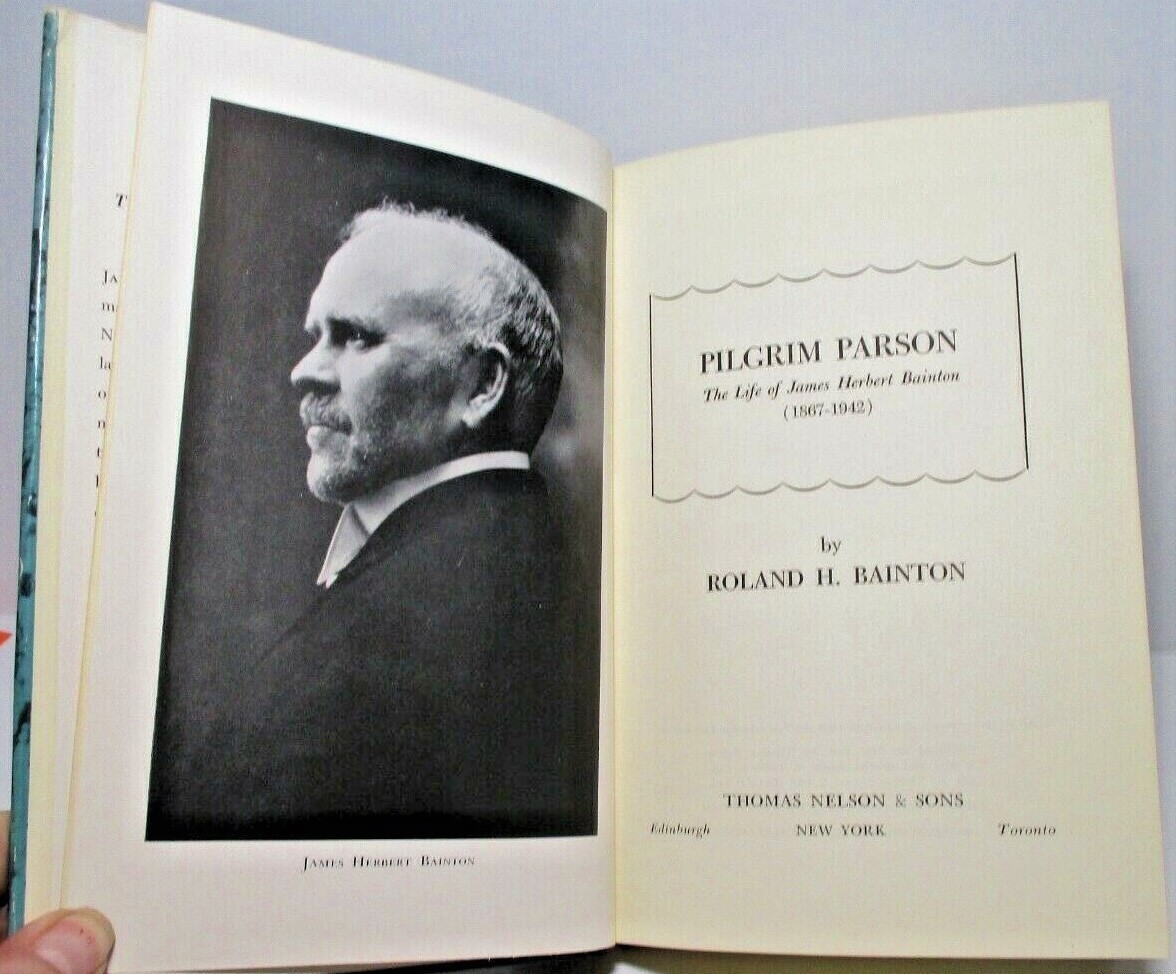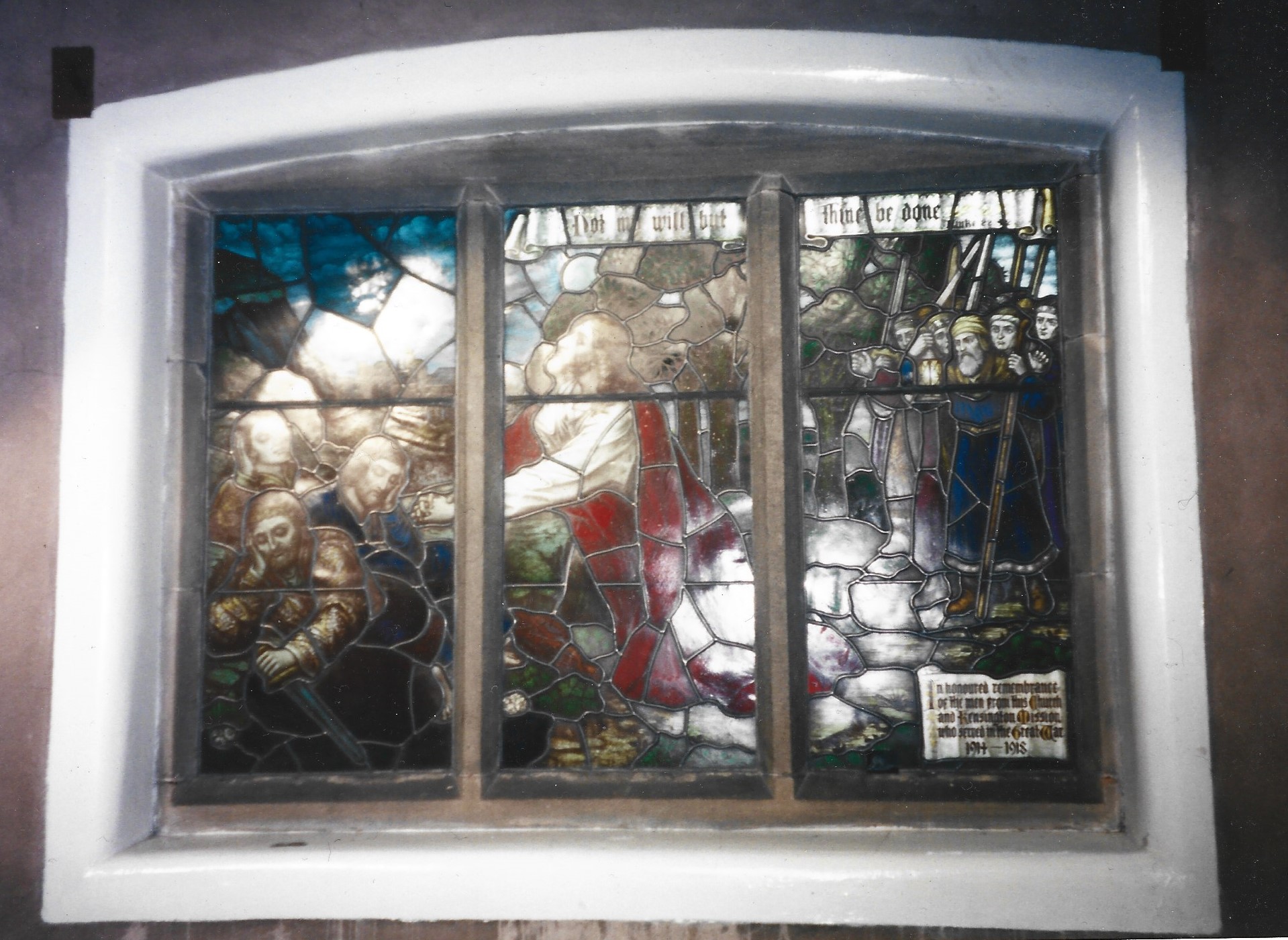Walking around the corner from the King’s Head in the Market Place, and into Pimlico we stumble upon the Independent Chapel and the Congregational community which Adeline recalls; “the Independent Chapel at the beginning of Pimlico was a very old one, and its services were well attended.” After the Unitarian (formerly Presbyterian) Chapel in Anchor Row it was the oldest Nonconformist establishment in the town.
Congregationalists assert that each local congregation of true believers is an identifiable unit held together in a covenant relationship and subject to no outside, human authority. This self-governing nature led to their original name of ‘Independent Church’.
—————————————————————————————————————————————————–
Timeline in the life of the Independent Chapel: late 18th Century -1904
In the third quarter of the eighteenth century we find Francis Ball, a Trowell man, taking a regular walk to Nottingham to attend and worship at Castle Gate Congregational Church, this being the nearest such church to his home. He later moved to Ilkeston while continuing to attend the Castle Gate church, but came to realise that ‘a spiritual source’, an Independent Church, was needed in Ilkeston.
Others shared his sentiment — men like Thomas Barker and John Bowes, who together had been travelling from Ilkeston on Sunday morning to Breedon on the Hill, to the church there.
1770 …. Meetings began to be held at John Bowes’ house in Pimlico and ministers were sent on weekday evenings from Nottingham Castle Gate, to lead the meetings. One such minister was the Rev. Robert Galland of Warwick.
1771 …. ”receiving encouragement from the generous friends of religion at Nottingham”, a new meeting house was established at Ilkeston.
1772 …. On August 25th the Independent Church at Ilkeston was formed.
Eight men and four women subscribed their names to ‘The Covenant, certain Articles of Faith and a statement of Church Discipline’.
The names of these pioneers are recorded as …
Alice Adkin or Attkin (nee Flint) at this time the wife of Moses, who died in 1773.
Then, in 1776, Alice married Joshua Gregory, farmer, at St. Mary’s Church, Ilkeston.
Francis Ball, stocking-weaver, who married Mary Sudbury, daughter of Thomas and Mary (nee Fox?) in 1776. (Their marriage entry in the Parish Register appears just before that of Alice and Joshua).
They had several sons and the family was to play an important part in the history of the lace industry in Ilkeston. (See And Balls).
John Bowes who died February 13th, 1789.
Sarah Eley
Hannah Hancock (nee Lacy) who had married Henry in 1761 and died in 1825.
Henry Hancock, stocking-weaver, who died in 1801 and was buried at St. Mary’s Church.
Matthew Lindley.
Thomas Making who died April 13th, 1816.
Edward Ridge who died July 16th, 1785.
John Sanders
Francis Thompson
Mary Wingfield or Winfield who died December 31st, 1805, aged 80, and was buried at St. Mary’s Church. (widow of Richard, nee Eley?)
1772 …. On October 14th eight more names were added to this list, including Thomas Sudbury.
The last on the list was Robert Galland, the first minister of the Church, ordained Pastor on November 4th, 1772 and served until 1779. His successor was the Rev. Thomas Hall. (And by 1797 the pastor was Benjamin Sugden)
At this time a ‘chronicler‘ wrote that “Ilkeston was a land of darkness and the shadow of death … Drunkenness, Sabbath-breaking, cock-fighting, bull-baiting, and all the low-lived scenes in connection with these sports extensively prevailed”.
With Edwin Trueman, R. Westland Moreland was the co-author of ‘A History of Ilkeston’ (1899). Writing in the Ilkeston Pioneer (July 1927) he mused on the ministry of the Rev. Galland and repeated an anecdote he had discovered in a pamphlet printed for the Religious Tract Society about 1831.
“While Mr. Galland was Minister at Ilkeston, an ungodly man threatened his life because he supposed that his preaching had contributed to the fanaticism of his son’s wife; a crime that could not be forgiven. He vowed vengeance no less than death and sought an opportunity to execute it; but the lord, who defends His people, took care of His servant, and shielded his head in the hour of danger. Having heard that there was a prayer-meeting at his son’s house, on the Sabbath-day morning, he repaired thither with the instrument of death: being hardened to his purpose by drinking all the preceding night. His companions in wickedness, however, endeavoured to dissuade him from his design, and to wrest the knife from his hand, with which he meant to do the business. He repaired to the place, breathing threatening and slaughter: but he was disappointed of his victim, for his information respecting the meeting was unfounded. However, God met with him in wroth, for on his return he fell into a ditch and was found dead, Thus the Lord took care of His servant and plentifully rewarded the evil doer”.
The historian concluded his article by posing the question ‘Between what years was Mr. Galland minister at Ilkeston ?
1781 … The first chapel and manse were erected on land given by John Bowes, a flax-dresser, who is reputed to have also contributed handsomely to the building fund. This is the year agreed by most sources, although in others there is mention of a meeting house ‘erected in 1771’. This may be reference to the house in Pimlico where the first meetings were held?
1808 …. A Sunday school was formed, under the Rev. Joshua Shaw’s ministry.
This was held in a small room, capable of holding about 80 children, built on the west side of the chapel and adjoining it. Children were taught ‘to read God’s word and keep the Sabbath’. One of these was Mary Ball, born in 1807, the daughter of Francis and Mary (nee Hirst) who joined the Sunday school at the age of three.
There is a suggestion that prior to 1808 a school had been operating in a building on the southern side of Pimlico, near to a passage leading onto what was later Albert Street.
Joshua Shaw was the brother-in-law of chandler Moses Mason of Bath Street, having married Mary Mason in 1801.
……………………………………………………………………………………………………………………………………
1816 … a visitor for the congregation !! … and exams for the children !!
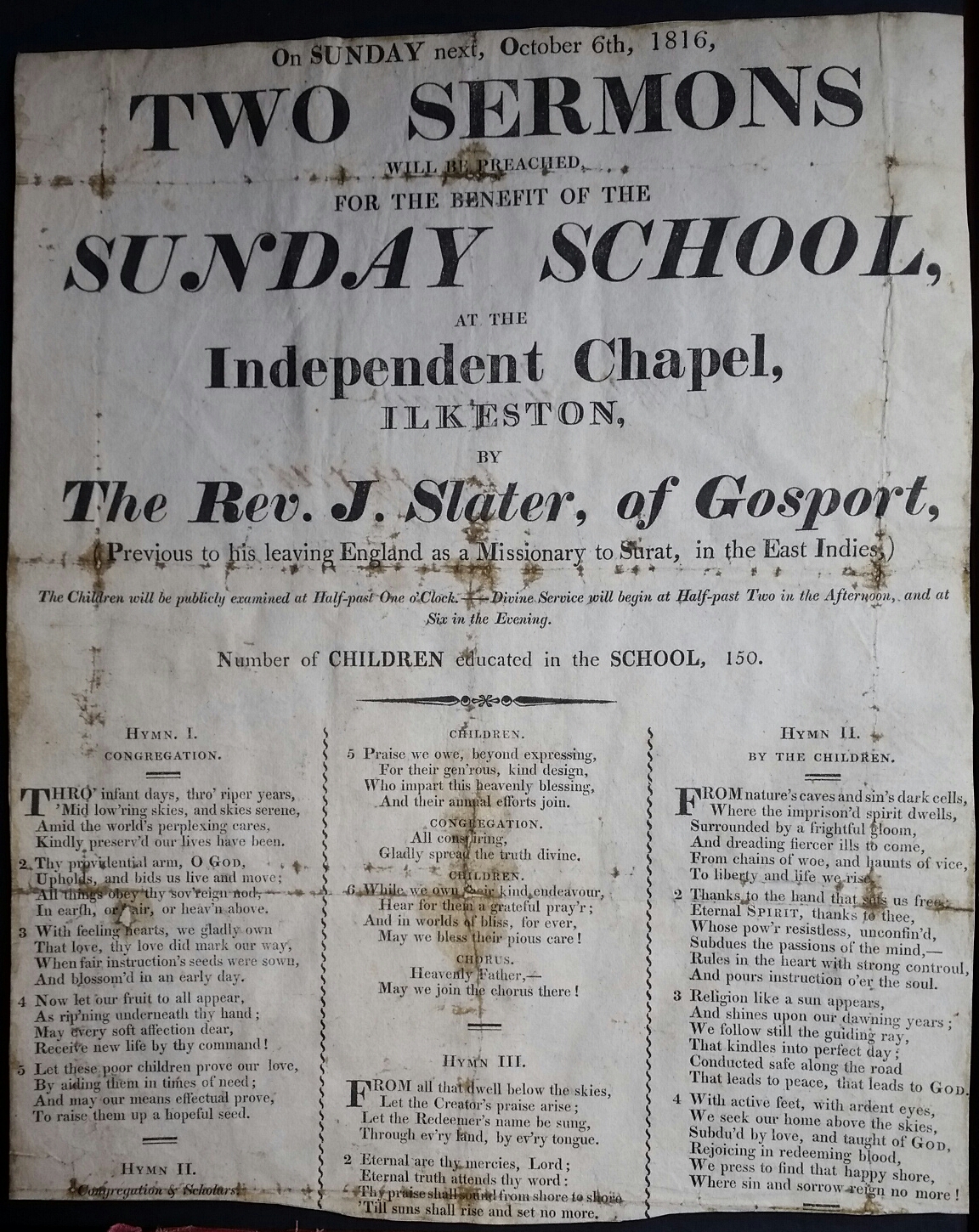 The handbill image is courtesy of the Andrew Knighton collection
The handbill image is courtesy of the Andrew Knighton collection
Andrew wrote that “I only acquired the Independent Chapel handbill just over a week ago. It had been for sale at a local car boot event and a friend of someone I distantly know who lives on the Shipley View estate picked it up and listed it on eBay on ‘buy it now’. I bought it and collected it from him on my way to visit my mother”. If only I could have such percipience !!
Born in 1789, John Slater studied at Gosport, Hampshire, where missionaries of the London Missionary Society (at that time simply called the Missionary Society) prepared for their ministries. He was ordained into the Congregational Church in August 1816 and in April 1817 he married Jemima Pincutt Nicholson at Fareham, Hampshire.
Shortly after, he was appointed to serve in Malacca, East Indies, and departed in May of that year, arriving at in December 1817.
In July, 1818, on account of ill-health, John took a voyage to Canton, China — both the voyage and the visit benefited him greatly such that he was able to return to Malacca a few months later. On April 27, 1819, he left Malacca for Batavia (now Jakarta), where he arrived on June 18.
In 1822, again for benefit of his health, John took another voyage, this time to Singapore and Penang, and thence returned to Batavia.
On October 20th, 1823, he was’ suspended by the Board of the Missionary Society. Subsequently he dissolved his connection with the Society.
(Taken from the Register of Missonaries, 1796-1923, prepared by James Sibree, D.D., for the London Missionary Society).
1831 …. much to the regret of his loyal congregation, Joshua Shaw left Ilkeston for Tutbury. He was followed, in September 1831, by the Rev. James Adolphus Savage who. one month later married Margaret Burrows in London. The couple left Ilkeston left about 1838. During James’s ministry a Sunday School was opened at Lewcotegate in West Hallam although, as it proved too successful for the ‘Church party’ in that parish, it was suppressed. He was followed by the Rev. Daniel Davies who was ordained on October 15th, 1839 and a month later, on November 15th, married Anne Harrison of Masbro’. He left Ilkeston in December 1844 for the Independent Chapel at Stansted, Essex, and the Ilkeston chapel was then left without a minister for almost two years before the arrival of Charles Hargreaves in October 1846.
1833 …. Thomas Harrison supplied the first Chapel organ.
1842 … A new Sunday School was built at a cost of £200. (1841 and 1844 are also quoted for this event although the Nottingham Review, September 1842, noted that new Sunday School rooms were being built at the chapel). When the Baptists of Ilkeston discovered that the opening of this school would clash with their planned baptisms at the Erewash Canal they postponed them until the next Sunday, closed their chapel in the afternoon and several of them then went along to the Pimlico chapel to hear the Rev. Savage who preached on the occasion. “Unity in Religion” ?
In December 1808 William Hawley, shoemaker of Pimlico, married Sarah Sudbury, daughter of William and Sarah (nee Thompson) and the niece of Mary, wife of the above-named Francis Ball. Shoemaker William gave evidence to the 1842 Children’s Employment Commission, inquiring into the employment and condition of children in mines and manufactories. He was then styled as ‘master’ of the Independent or Calvinist school in Ilkeston, which had ‘105 girls and 106 boys on its list’, admitted from the age of five, classes starting from nine a.m. and finishing at four p.m.
William thought that those children working in the pits for up to 14 hours were ‘much more dull and stupid than the others’. ‘He has often to complain of the colliers’ children’s bad attendance on Sunday mornings and the reply generally is, they are so tired they overslept themselves’.
1846 … Charles Hargreaves, a senior student at Airedale College, Yorkshire, arrived at the chapel in October. In May 1847 he was ordained at the chapel. And on January 19th, 1848 he married Elizabeth Adamson of Halifax at Wilsden Independent Chapel.
1848-49 …. A new chapel was built in Pimlico.
By June 1848 plans for the new chapel were on display at the old chapel and tenders for its erection were being sought. By the end of July the old chapel was no more — the site had been cleared for the new chapel to rise up.
To oversee its building and to collect subscriptions, a committee was set up, featuring many men prominent in the development of Ilkeston at this time……
Matthew Hobson, grocer, farmer and miller of the Market Place.
Thomas Merry, grocer and druggist of the Market Place.
Robert Burgin, blacksmith of South Street.
William and John Ball, sons of Francis, lace manufacturers.
Samuel Straw, canal agent of Moors Bridge Lane (Derby Road).
George Purcell, chemist and druggist of Bath Street.
Francis Sudbury, glove maker and hosier of South Street.
William Lovejoy, schoolmaster of South Street.
The chapel was begun on August 1st, 1848 and finished on March 31st, 1849 at a cost of £750. It was officially opened on April 10th, 1849 and on May 24th licensed for the solemnization of marriages. The first marriage there was that on June 19th between Jane Taylor, youngest child of farmer John and Hannah (nee Cocker, dec.) of Little Hallam, and James Wood, canal agent of Trent Lock. As a mark of the occasion, the couple received a copy of John Morison’s “Counsels to a Newly-wedded Pair” and “The History of the Independent Church, Ilkeston“, presented by the Rev. Hargreaves. The chapel remained open until March 22nd, 1905.
The 1851 Religious Census gave an estimated national membership of 165,000.
The same census noted that the Pimlico chapel had 320 sittings, none of them free, “professedly so and marked out as such. Yet there are poor people amongst us who regularly occupy sittings without any charge – thus enjoying the advantage of a free sitting, without having the badge of poverty affixed to it”.
(This was the note added by the Independent Minister Charles Jonas Hargreaves of Boot Lane, later known as Stanton Road).
Average morning attendance of the general congregation was 130 with a Sunday school of 70, while the evening congregation was 200 with a Sunday school of 30.
April 1853 …. after nearly seven years as minister at the chapel, Charles Hargreaves left Ilkeston to become pastor at the Congregational Church in Cheadle, Staffordshire. His place was taken by the George Hoatson who arrived in November 1853 and resigned in February 1855.
In the early 1860s a gallery for the Sunday school children and singers was added in the chapel. The pulpit was altered for the convenience and comfort of the minister. And an organ was purchased and erected in the gallery.
Newly-arrived in Ilkeston, Master of the British School in Bath Street, Wright Lissett was appointed as the first organist. And soon after, the Church resolved to sell off their double bass to help clear the ‘gallery and organ’ debt.
One instrument that was not sold was the ‘old-fashioned wooden pipe or flute’, which was reputed to have been used by Joshua Shaw in his services. This instrument found its way into the possession of grocer Moses William Mason and his wife Emma Elizabeth (nee Maltby), sister of Charles Maltby, lace manufacturer of Dalby House. She later (about 1928?) left for Canada, unaccompanied by the flute.
1864 …. One Sunday morning, William Sudbury, butcher of South Street, and Richard Powell Howard, engineer of Belper Street – who were also Superintendent and teacher, respectively, at the chapel Sunday school – were strolling down Nottingham Road when they caught sight of a band of dirty and ragged children. The idea for a Sunday school in that area was then formed in the mind of the Superintendent and the Kensington Mission was soon established ‘to educate the dirty and ragged children of that area’, its first session being held on August 4th, 1864.
But not everyone in the Kensington area was happy to hear their children described as ‘ragged’.
An indignant ‘Martha Marlow’ wrote to the Pioneer (Jan. 26th 1865) on behalf of herself and several other Kensington mothers, declaring that her children were clean, neat and not dressed in rags. Though poor, they did have their standards!
Initially the schoolroom of the Mission was in a cottage loaned by Benjamin Tatham, a master needlemaker who lived in Needlemaker’s Yard (Kensington Street). Richard Powell Howard led the singing and William Sudbury addressed the children who clearly enjoyed the proceedings. After three weeks the mission was such a success that larger premises were needed. A second cottage was loaned and then the club- room at the Needlemakers’ Arms was used. By the end of the year there were about 70 scholars attending.
In 1865 the Mission Station at Kensington was officially recognised as a branch of the Mother Church.
A Committee of Management, with a Pastor and Treasurer (Matthew Hobson), was appointed.
In early 1866 the Mission again moved into new premises … the middle room of a nearby factory, damp but merely temporary. Efforts were already afoot to raise finance for more permanent accommodation, for a Sunday school and congregational worship.
1869-1870 … Premises for the Mission (above) were built and dedicated, on land donated by Matthew Hobson, at a cost of £300. The photo is from the personal collection of Jim Beardsley
At the end of 1881 the Mission Room was rented by the Ilkeston School Board to provide a temporary infants’ school in the area while a more permanent school could be built.
The Independent Chapel in Pimlico c1901. (Ilkeston Reference Library)
We are looking at the chapel from the direction of the Market Place. Burns Street is on the right.
And in the map below, Burns Street is on the right … notice the absence of houses around the chapel.
Above is a view of the chapel taken about 2000, again looking at it from the Market Place end of Burns Street. By this time the chapel had been converted into apartments. And below is a view looking towards the Market Place. You can clearly see the Scala Cinema, immediately to the left of the former chapel.
1894 … the boiler regulating the hot-water system at the Chapel exploded in January. The said boiler jumped a few feet in the air and landed a yard from its original position. No-one was injured but the services for the following Sunday had to be moved to the Town Hall. The apparatus had been installed about two years previous. It cost nigh on £50 to get the boiler repaired.
At this time the weather throughout many parts of the country was particularly inclement, with severe frost and fog. The Chapel incident was one of many similar exploding boiler accidents reported; one of them at Ashton-on-Ribble, near Preston, killed a nine-year-old lass while another at Leeds Adel Reformatory killed inmate William Paley. Fatalities from cold up and down the country also occurred as did deaths whilest skating.
1904 … Work was begun on a new church in Wharncliffe Road designed by local architect Harry Tatham Sudbury. On April 9th memorial bricks were laid for the Sunday School, followed on April 27th by memorial stones for the church being laid. The opening ceremony for the church was March 22nd, 1905 when the congregation, headed by the minister, walked from the old chapel to the new church.
“I suppose when the Wharncliffe Road Church was built, the name Independent was changed to Congregational” (Adeline)
And below are two views of the ‘new’ Congregational chapel in Wharncliffe Road.
———————————————————————————————————————————————
The Ministers.
Adeline recalls some names ... “It had resident ministers, Revs. Heron, Allsebrook and later on Rev. Bonser.” Her recollections seem to be primarily of the 1860’s and 1870‘s. Of the ministers she mentions…..
Ebenezer Sloane Heron arrived in Ilkeston in January 1856 after his seven-year pastorate at Denholme near Bradford and was minister until December 1861. He then left for Bingley, Yorkshire, having raised the church membership total to 79.
“He was a man fixed with an evangelical zeal and burnt up with the desire to save one soul alive whilst yet ‘twas day…. His sympathy and abounding goodness to the poor and sick won for (him) widespread respect, whilst by many he was greatly beloved”.
Ebenezer had married Elizabeth Ayrton in 1852 and the couple lived at Chapel Yard, adjacent to the Independent Chapel, in Pimlico.
During their time in Ilkeston Elizabeth gave birth to four children … John William (1856), Jessie Carrie (1857), David Ayrton (1859) and Elizabeth Ann (1861).
Ebenezer and Elizabeth spent their final days in Knoxville, Knox County, Tennessee, and the former minister died there in December 1887.
Their son John William (right) was born in the Pimlico Manse at Ilkeston on June 15th, 1856 and died in Korea on July 26th, 1890. He was at that time serving as physician to King Gojong.
He had accompanied his parent to the USA where he studied at Maryville College and in 1883 graduated with honours in the medical department of the University of Tennessee at Nashville.
He then settled in Jonesborough, Tennessee but later studied in the New York Medical University while practising in an almshouse on Blockwell’s Island.
On April 23rd, 1883 John married Harriett Elizabeth ‘Hattie’ Gibson of Jonesboro and on May 1st the pair set sail for Korea.
Thereafter he served as the king’s household physician and when he died, was accorded State honours — his grave was the first one upon ground ever given by the King to a foreigner.
The monarch donated three acres of land about four miles from Seoul, an a hill overlooking the river, for the burial site.
This was to be the Yanghwajin Foreign Missionary Cemetery in Hapjeong-dong, northern Seoul (left).
“I remember the Rev. R. Allsebrook. (He) was the first to live in the new house in Market Street, now the Anchor Inn.”
Robert Allsebrook, a student of Spring Hill College, Birmingham, began as pastor in August 1862 and was, strangely enough, publicly ordained to the ministry in Ilkeston only on March 3rd 1863 when “the congregation filled the chapel both in the afternoon and evening. The day was remarkably fine, and allowed friends to congregate from places many miles distant from”.
Robert struggled with illness throughout most of that year and died of consumption on December 27th, 1863, aged 27, at the home of his parents at Chadwick Manor House near Bromsgrove, Worcestershire.
“For the short space of time that he was (in Ilkeston), he made considerable impression upon the minds and hearts of the people. .. As a preacher he was much esteemed, and as a man his character and disposition were such as to commend him to all
“In Sunday school … he had an astonishing command. He was greatly beloved by the scholars, despite the fact that he was a born disciplinarian. Commotion, ‘tis said, died down so soon as he entered the room”.A marble tablet to his memory was placed inside the Independent Chapel, by Mary Ball, (it is said), his betrothed.
“I remember the … Rev. W.W. Jubb.”
There was a gap of several months until the arrival of Rev. William Walker Jubb at the chapel in May 1864.
He served until January 1867 and during that time took a prominent part in the establishment of the Ilkeston Working Men’s Club and the Kensington Mission Church (see above).
He moved on to Oldbury in the district of Birmingham.
From 1891 he was Pastor of the Central Congregational Church in Fall River, Massachusetts, of which an active member was Lizzie Andrew Borden, arrested and tried in 1892 for the murders of her father and step-mother.
Throughout her ordeal he was ‘a strong and vocal champion of Lizzie and a firm believer in her innocence’, constantly at her side, and continued to support her after her acquittal in 1893.
He died at Illesley near London in 1904.
“In the ‘Ilkeston Advertiser’ of Aug. 13th I saw the Rev. Alfred Bonser had passed away. It brought to my memory pleasing thoughts of his father, the Rev. John Bonser. When the Rev. John Bonser retired from the ministry he went to live in Addison Villas, Addison Street, Nottingham. When my family went to live at Nottingham, we were close neighbours, and I understand that their only child, the late Alfred, was born at Addison Villas, and when he had passed his studentship at Paton College, Nottingham, he proposed going for a missionary, and I believe did so.”
John Bonser B.A. was at the Ilkeston Independent Chapel from May 1867 to 1872. Shortly before his arrival at Ilkeston in 1866, he had married Elizabeth Septima Paddon, daughter of borough magistrate and timber merchant John and Mary Ann of Truro, Cornwall. She served as a teacher at the Sunday school for only a short period. She died at Chapel House in South Street on March 26th 1869 and three days later their recently-born daughter Emily was baptised at the church.
In February 1872 John married again, to Isabella James of Nottingham, and two months later the family left for Rawmarsh near Rotherham. On his departure his Ilkeston friends presented John with an engraved English lever gold watch and gold pencil case, ‘as an expression of kindly feeling and regard’ and in the hope that ‘you may live many years to wear them, and by their constant use be often reminded of those who so willingly and cheerfully contributed to their cost, and thus be greatly stimulated and encouraged in your ‘work of faith and labour of love’.
One of John’s last acts as Independent Chapel minister was to officiate at the marriage of Elizabeth Ann Ball and Dr. Robert Wood, whom we shall meet shortly.
The son Alfred was born in Rawmarsh in 1872 though the family did later live at 12 Addison Street in Nottingham — after John’s retirement in the late 1880’s and until his death – and after.
In February 1873 the Rev. David ‘Daddy’ Waters of Hockcliffe, Bedfordshire was appointed as pastor at the church.
He was the zealous orator wherever he went – in the street, in the town’s shops, in local pubs — and on Saturday evenings could be found preaching outdoors in the Market Place where he beseeched the unconverted to avoid Hell by ‘reconciling’ themselves to God. But despite his zeal, or perhaps because of it, David seems to have offended some of the Church leaders, one of them being the forceful lay preacher Wright Lissett.
“(Mr. Waters) was liked in the town and beloved by the young people in the Church. He was good-hearted…. but after the scholarly Mr. Bonser, whose sermons (be it said) were often ‘over the heads’ of the congregation, Mr. Waters, when weighed in the balance, was found wanting. The trouble was not with the good man himself. He was sterling gold. It was simply that he was a square peg in a round hole. Peg and hole did not fit”. (WWG)
David left for Sheffield in July 1875 and “the church entered upon the troubled waters of a long interregnum in the pastorate”….
…. until in January 1878 the Rev. John Fleming, late of Spring Hill College in Birmingham, became pastor at an annual salary of £130 plus the free use or letting of the house adjoining the church.
On December 4th 1890, at an evening re-union of old scholars, held at the chapel’s schoolroom, John announced his resignation of the pastorate. His final serman was scheduled for December 21st.
During his 12 years in the town, John had been a member of the School Board for six years from 1881 to 1887 and was on the Board when the Granby Schools opened; he was instrumental in getting penny banks estblished in Board Schools in 1883; he was the local secretary of the British and Foreign Bible Society, and leader of the Home Reading Movement in Ilkeston. His resignation came at the very time that a local committee of the last-named Movement was being organised in the town, supported by the former Mayor, Francis Sudbury. Its purpose was to circulate ‘good and useful publications amongst the people’, to encourage a taste for reading, especially among the young. And home study was another aspect of group, people combining together to read systematically at home. It was open for anyone to join one of these circles for a small annual subscription of about 1/6d or 2s — any young person could afford to pay this in the year. Francis pointed out the town’s lack of a public library — perhaps there would be one soon ? — but this Movement would be a great help to all those seeking good and useful literature.
Through his efforts, the Pimlico chapel had been renewed and renovated at a cost of £300, and had bought a new organ for £170.
In November 1891, the Rev. James Herbert Bainton arrived. He was born in Stebbing, Essex, in 1867, and came from a ministerial family, with a grandfather, father and three uncles in the Congregational movement. He studied at Lancashire Independent College and Owen’s College, Manchester from 1885 to 1891. His B.A. degree was taken at Victoria University in 1888 followed by an M.A. in 1890.
In 1898 a scheme for a “Century Church” was put to the deacons. This envisaged a special effort to secure a new church “more befitting the cause and the times than the present structure, in readiness for the twentieth century”. Sadly this effort was too little and too late for James Herbert Bianton who felt that the church was merely marking time. In February 1898 he unexpectedly accepted the pastorate of the First Congregational Church at Vancouver, British Columbia. This action was a complete surprise to his congregation and was the result of his dissatisfaction with the progress — or lack of it — which the Ilkeston chapel was making towards erecting the new and more worthy premises. James Herbert regarded the old Pimlico chapel as out-of-date and almost disreputable; for him, the position which Congregationalism should hold in the town immediately demanded a finer structure. It should be noted that this was at a time when the Methodists had just formally opened their new and most impressive Bath Street church which had just been visited by Charles Frederick Aked.
With his wife and children the Rev. Bainton left Ilkeston a month later (May 19th), but not before he was given a most warm ‘farewell’ by his congregation and by the Non-Conformist Council of Ilkeston (James Herbert was its secretary) on May 11th. At this occasion he was presented with a framed and glazed illuminated address designed by Thomas Roe, printer of Bath Street — it featured illustrations of the Independent, Wesleyan, U.M.F.C., Primitive Methodist and Methodist New Connexion Churches, the borough arms, and the monogram of the Ilkeston Free Church Council around its border. At this time there were 18 Free Churches in Ilkeston.
The Bainton family left aboard the S.S. Scotsman of the Dominion Line, from Liverpool bound for Quebec, the journey taking just over a week. In September of the following year that steam ship, making a similar voyage, was wrecked near Change Island, Newfoundland and Labrador, with the loss of 11 lives.
It wasn’t until March of 1899 that the vacancy left by the Rev. Bainton was filled by Welshman, the Rev. Thomas Gwyn Thomas coming from Brigg, Lincolnshire, where he preached his final sermon on April 26th. He had been pastor there for four and a half years and left with a testimonial of 19 volumes of theological works. On Sunday, May 7th, Thomas preached his first sermon while the recognition service was fixed for May 10th.
——————————————————————————————————————————————–
To be found in the United Reform Church at Wharncliffe Road.
In honoured remembrance of the men from this church and Kensington Mission who served in the Great War 1914-1918.
———————————————————————————————————————————————-
And next? Guess what ? Another Inn. The Sir John Warren.

